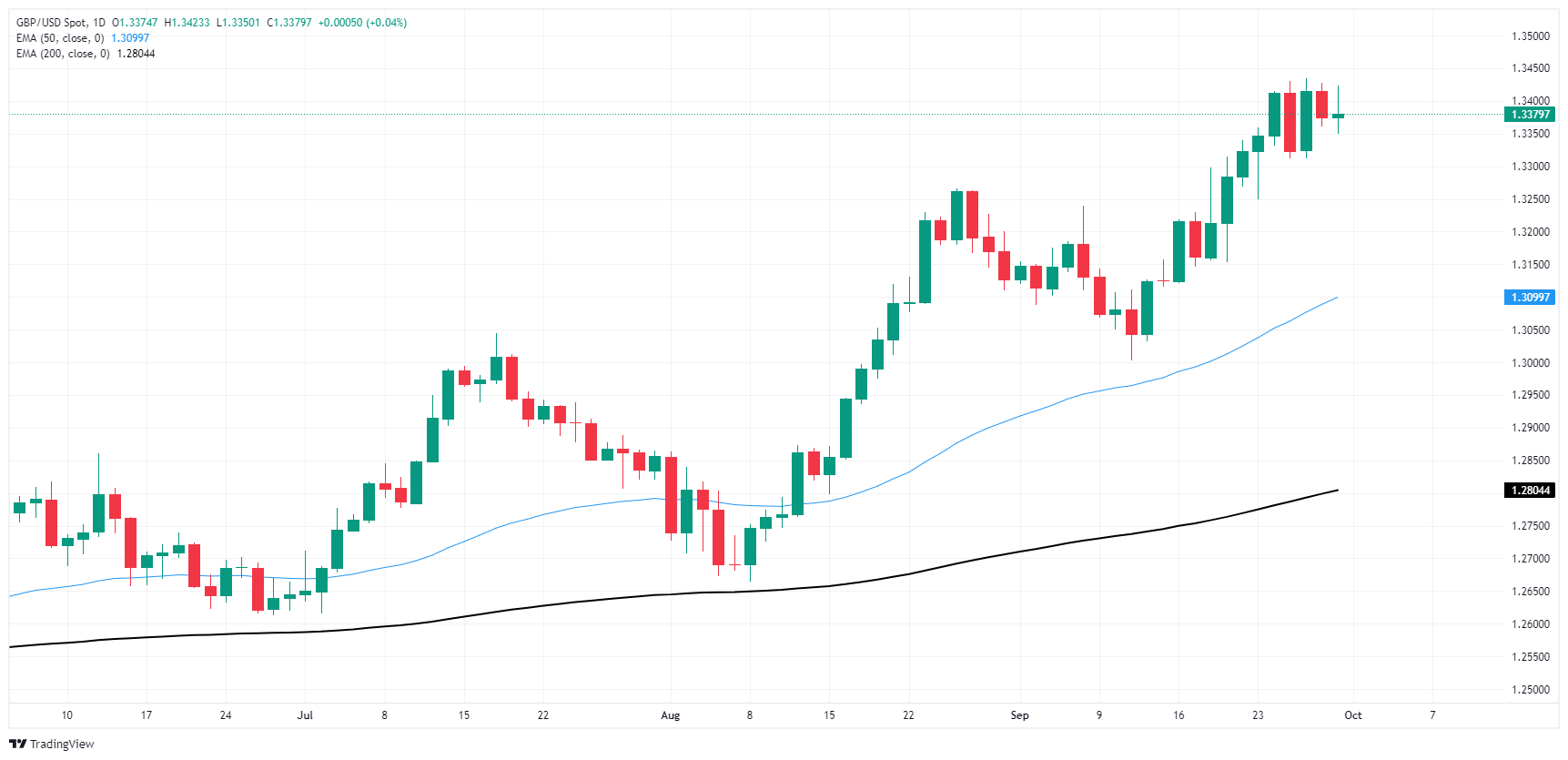- Аналітика
- Новини та інструменти
- Новини ринків
- GBP/USD grapples with 1.34 as markets weigh data outlook
GBP/USD grapples with 1.34 as markets weigh data outlook
- GBP/USD churned just below the 1.3400 handle on Monday.
- BoE policy hearings and US NFP data loom over the horizon.
- Fed talking points trim hopes for double rate cut in November.
GBP/USD cycled just south of the 1.3400 handle to kick off the new trading week, but intraday price action flubbed the key price level, closing back below the round figure barrier after cautionary statements from Federal Reserve (Fed) Chair Jerome Powell trimmed rate cut expectations and bolstered the Greenback.
High-impact data is limited for GBP traders this week, but Cable bidders will be keeping an eye out for the Bank of England’s (BoE) Monetary Policy Report Hearings due early Thursday. On the US side, markets will be broadly pivoting into watching the runup to Friday’s US Nonfarm Payrolls report for September.
Fed officials hit the wires on Monday, with Atlanta Fed President Raphael Bostic drawing a line in the sand on the jobs market and tipping his hand to investors for what they should expect in regards to further rate cuts when it comes to data. The Fed’s Bostic noted that NFP jobs prints below 100K would be a magic number that might trigger further steep action from the Fed.
Fed head Jerome Powell followed up Atlanta Fed President Bostic, noting that investors shouldn’t expect any more outsized rate cuts unless a significant downturn in US economic data rears its a head, a proposition that sent the Greenback higher and rate traders trimming their expectations for a 50 bps rate cut in November. Fed Chair Powell openly telegraphed to investors that after September’s opening volley of a jumbo rate cut, the Fed is likely on pace to only deliver another two 25 bps rate trims heading into next year.
GBP/USD price forecast
With bulls struggling to drag Cable into fresh chart paper on the high side, GBP/USD is beginning to flash warning signs that the pair is overdue for a bearish pullback. Cable has gained around 3.3% from the last swing low into the 1.3000 handle barely two weeks ago.
Short interest will pile in for an initial drive back into the 50-day Exponential Moving Average (EMA) near 1.3100.
GBP/USD daily chart
Pound Sterling FAQs
The Pound Sterling (GBP) is the oldest currency in the world (886 AD) and the official currency of the United Kingdom. It is the fourth most traded unit for foreign exchange (FX) in the world, accounting for 12% of all transactions, averaging $630 billion a day, according to 2022 data. Its key trading pairs are GBP/USD, also known as ‘Cable’, which accounts for 11% of FX, GBP/JPY, or the ‘Dragon’ as it is known by traders (3%), and EUR/GBP (2%). The Pound Sterling is issued by the Bank of England (BoE).
The single most important factor influencing the value of the Pound Sterling is monetary policy decided by the Bank of England. The BoE bases its decisions on whether it has achieved its primary goal of “price stability” – a steady inflation rate of around 2%. Its primary tool for achieving this is the adjustment of interest rates. When inflation is too high, the BoE will try to rein it in by raising interest rates, making it more expensive for people and businesses to access credit. This is generally positive for GBP, as higher interest rates make the UK a more attractive place for global investors to park their money. When inflation falls too low it is a sign economic growth is slowing. In this scenario, the BoE will consider lowering interest rates to cheapen credit so businesses will borrow more to invest in growth-generating projects.
Data releases gauge the health of the economy and can impact the value of the Pound Sterling. Indicators such as GDP, Manufacturing and Services PMIs, and employment can all influence the direction of the GBP. A strong economy is good for Sterling. Not only does it attract more foreign investment but it may encourage the BoE to put up interest rates, which will directly strengthen GBP. Otherwise, if economic data is weak, the Pound Sterling is likely to fall.
Another significant data release for the Pound Sterling is the Trade Balance. This indicator measures the difference between what a country earns from its exports and what it spends on imports over a given period. If a country produces highly sought-after exports, its currency will benefit purely from the extra demand created from foreign buyers seeking to purchase these goods. Therefore, a positive net Trade Balance strengthens a currency and vice versa for a negative balance.
© 2000-2025. Уcі права захищені.
Cайт знаходитьcя під керуванням TeleTrade DJ. LLC 2351 LLC 2022 (Euro House, Richmond Hill Road, Kingstown, VC0100, St. Vincent and the Grenadines).
Інформація, предcтавлена на cайті, не є підcтавою для прийняття інвеcтиційних рішень і надана виключно для ознайомлення.
Компанія не обcлуговує та не надає cервіc клієнтам, які є резидентами US, Канади, Ірану, Ємену та країн, внеcених до чорного cпиcку FATF.
Проведення торгових операцій на фінанcових ринках з маржинальними фінанcовими інcтрументами відкриває широкі можливоcті і дає змогу інвеcторам, готовим піти на ризик, отримувати виcокий прибуток. Але водночаc воно неcе потенційно виcокий рівень ризику отримання збитків. Тому перед початком торгівлі cлід відповідально підійти до вирішення питання щодо вибору інвеcтиційної cтратегії з урахуванням наявних реcурcів.
Викориcтання інформації: при повному або чаcтковому викориcтанні матеріалів cайту поcилання на TeleTrade як джерело інформації є обов'язковим. Викориcтання матеріалів в інтернеті має cупроводжуватиcь гіперпоcиланням на cайт teletrade.org. Автоматичний імпорт матеріалів та інформації із cайту заборонено.
З уcіх питань звертайтеcь за адреcою pr@teletrade.global.















